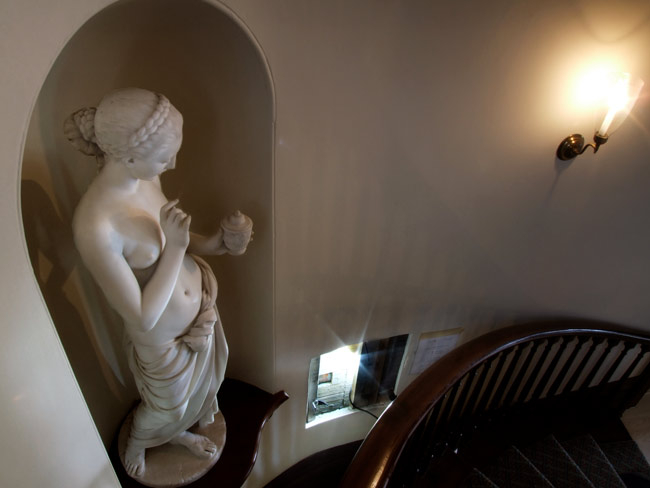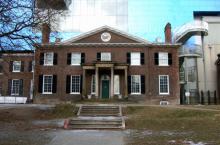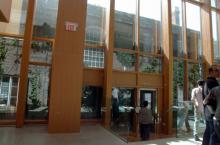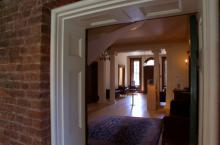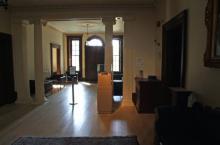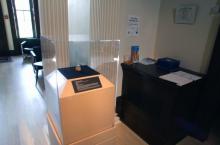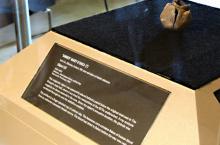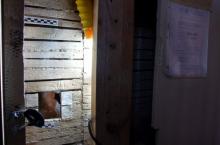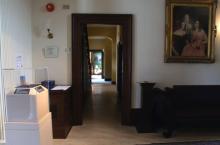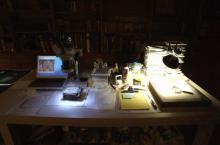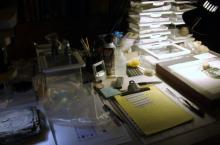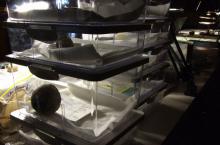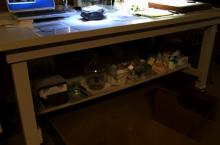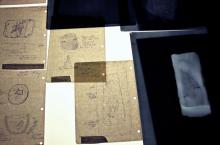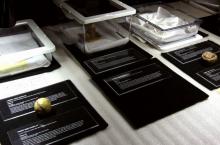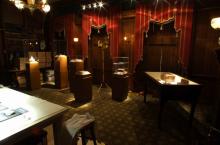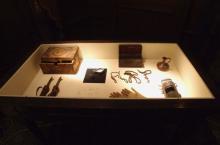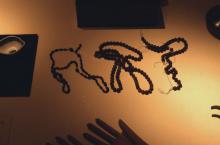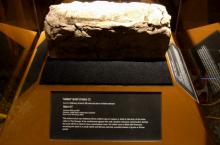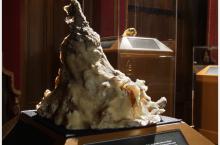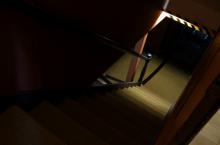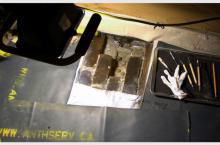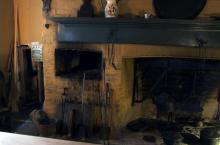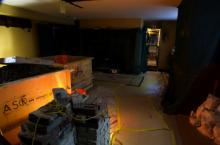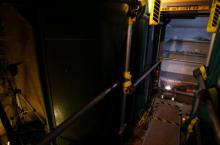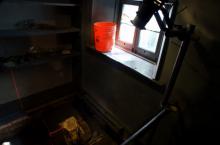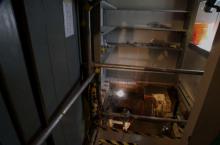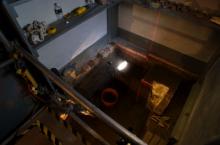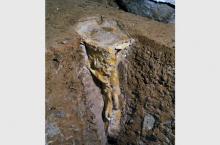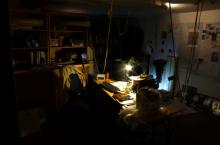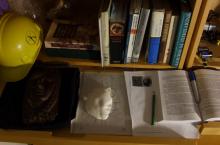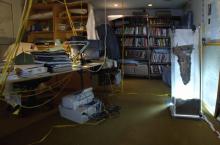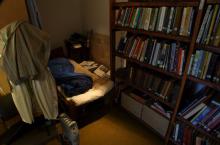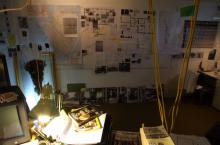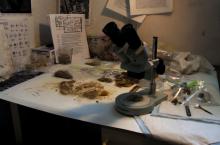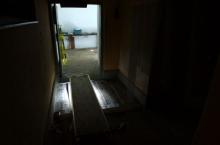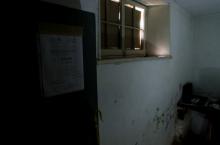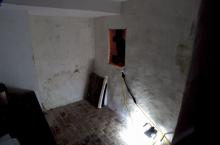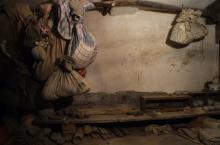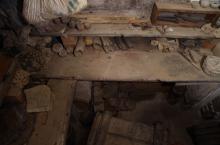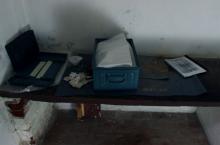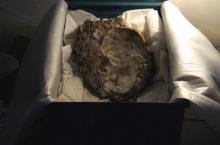Main Hall
Tour narrative, from the Tour-guide's training handbook.
In June 2007 The Grange received a bequest from James S. Whyte, Boston, Massachusetts, USA. James' father had recently died and he left his son a legacy of papers, in which James found diaries of his great-grand-uncle, Henry Whyte, who had served as a butler in The Grange for almost 40 years. In 1828 he remarked on Mary O'Shea, a seventeen year old Irish woman, recently arrived, who was hired as third maid.
(text continues after gallery...)
He witnessed that Mary had scraped drops of bees-wax from a candle holder and stuck them to a small ball of wax she kept in her apron. It would normally have gone into the reclaiming pot, but the quantities may have been considered insignificantly small. One finds six more mentions of such "incidents" over the next 4 months; then nothing, until about a year later he writes about having seen her slipping a small object between the floor boards of the stable, which upon his inspection turned out to be a "waxen globule".
Over the years he must have seen her occasionally placing objects into various locations in the house, stables and adjoining garden, Henry began to draw a map of her hiding spaces. Essentially, his records are confined to little crosses on his map. But these marks continue for approximately 28 years and end only when Henry retired and left the household. Thirty four hideaways were numbered. And, significantly the maps were titled "Amber", probably referring to the visual appearance of the wax-pieces that remind of fossil-ambers.
When Archaeological Services Ontario (ASO) were hired by the AGO to probe the walls and floors for some of the spaces, a veritable Pandora's box of items was retrieved one by one. Some of the assessment sites are still under preparation and retrieval. Some have already been re-closed and only signage of the feature remains visible.
As part of its Transformation reopening, the AGO is making the ongoing Excavation Project Activities publicly accessible for a limited time.
The Library
Many of the artifacts that have been retrieved by the archaeologists are in surprisingly good condition. Wax is a very inert material and some of the objects have been protected by an unfired layer of clay, taken from the grounds of The Grange.
Four main categories of objects can be distinguished that were concealed by Amber. These four categories correspond roughly to four phases when, over time, Amber explored and developed different methods as she obsessively fabricated and concealed her little "waxen globules" – as Henry Whyte called them once in his notes. A confident timeline of Amber's work can be derived from the dates that Henry Whyte had recorded on his map. However, most of the sites on the map are no longer accessible, since they have been demolished together with the stables and sheds that were torn down when the AGO's new building was constructed. Others must have been obliterated during the extensive renovations of the 1970s because some of the re-opened sites were found to be empty. However, a number of sites that were not recorded by Whyte have also been discovered in the meantime.
The first category of objects are little marbles of wax. They are dated to have been made soon after Amber's arrival in Canada. Apparently, they were hand-rolled from left-over pieces of beeswax that have been warmed, kneaded and softened in the hand, as slowly, over time layer upon layer was added and everything rolled into a solid sphere of wax. They are not entirely homogenous however, as they usually contain some object that must have had special significance for Amber at that time. These are everyday items, for example one marble contained a well preserved louse and a flea which now provides scientist at the University of Toronto with an opportunity to study the genetic material of 150 year old parasites.
The second category we can distinguish are small clay containers, fashioned from clay that is a bit lighter than the clay found on the grounds of The Grange, from which the bricks of the house were fired. Amber's pots were however unfired. We can see an intermediate stage - marbles that were coated with a layer of clay, but at some point Amber started to work with molten wax. She pinched small pods and poured molten wax in them, poured from a pot or can, encasing small objects. Two such artifacts were found that have been closed with a lid, and on one such lid we can clearly discern a thumbprint, applied like a seal to the contents it conceals.
The third category – of which only a small number of examples have been discovered – are larger objects that may have been dipped into a pot of molten wax. There is an example under the microscope and this is currently under preparation. It appears to be a stack of letters. It's creation is assumed to fall sometime between 1848 and 1855, when Amber was already a senior staff member with over twenty years of service in the household. Amber must have established her own, limited level of privacy and trust at that time, to be able to pursue her obsession at that scale. Even so, the stack of letters reminds us of how scarce and precious even simple materials were in these days. It is well established that people wrote with lines criss-crossing at right angles to each other, to be able to fill a page of a letter with twice the amount of text. Lines of handwriting can be clearly distinguished, crossing each other. Further investigation is facing a dilemma: whether to dissect the letters from their hull and thus destroy the object, whether to conserve the object as it was intended, and keep the contents of these letters forever a secret, or whether to hope for some future technology that will allow us to peer between the layers.
The last category, executed at a scale that is almost hard to believe, consists of a massive cone of wax, cast into a hole that was dug into the ground. An estimated 3.3 L of liquid beeswax must have been carried by Amber in some quiet, moonlit night through the house, to the front of the mansion. The surprising fact is that this object was actually not discovered by the Excavation Project, but chanced upon by a vigilant construction worker during trenching work as part of the AGO Transformation, in 2005. At first, this object was categorized as refuse, possibly from a candle-light party of the gentry who had made the house a centre of bustling social activity. Only when the other artifacts within the Grange were discovered, was the connection to Amber's authorship made. Virtual proof of the connection was obtained in August 2008 when the excavators discovered Object 17 under the brick floor of a former storage cold-room.
The Goldwyn Smith Library was built as an addition to the house in the 1890s and it is therefore certain that Amber never set foot into this room. Moreover, the representative first floor was the domain of the masters and of the butler. A servant's life took place beneath the floorboards.
Dr. Chantal Lee, the excavation coordinator is currently working working mainly in the basement to reconstruct Amber's biography and investigating into her motives.
1817 Kitchen
This kitchen was a part of the original construction of the house by D'Arcy Boulton in 1817. This room is therefore 193 years old.
At times The Grange employed ten servants. The work was hard, the days were long, and the bake room hot. It took hours for this brick oven to become hot enough to bake bread. After the oven was thoroughly heated, the ashes were brushed out and the shaped bread-dough was slipped in on wooden boards. A good baker would have the experience, and sense the time it takes to pull it out again, freshly baked. Meat was roasted on a spit rotated by a spring mechanism. When Amber came to The Grange as a young woman of 17 years, she probably worked here first. She certainly did a lot of cleaning, taking care of the fire, removing the ashes, fetching wood, collecting the eggs from the chicken stables, picking up the milk-can and so on. If she had been in charge of stoking the fire and maintaining it, especially in the winter, this would have provided an excellent excuse to get up at night with a chore. The female servant's sleeping quarters were located in the attic, four maids lodging in tiny room, and Amber may have tiptoed through the entire house, from attic to basement, each morning, long before sunrise.
Over the decades her status and position would have changed, becoming an assistant cook or later taking care of the laundry. She must certainly have had enough authority among the servants to maintain a small amount of privacy and mobility, secretly of course, in her masters house. It may have helped that these masters were quite busy with their own affairs, since William Boulton was hugely in debt and it was only the wealth of his wife's family that saved the property. Incidentally, William's wife was also the owner of the house, since Sarah Ann Boulton (née Robinson), William's mother who had always lived in the same house, had bequeathed the mansion to her daughter-in-law, rather than to her son. The house was therefore passed on in a female lineage which is very unusual for the time. William's wife was Harriette Boulton (née Dixon), who much later willed this house to become the first home of the Art Gallery of Ontario.
The excavations in the 1817 Kitchen probably have discovered Amber's earliest hideaways. But as this is the kitchen here and there is no warmer room in the whole house, some of Amber's early pieces were unfortunately absorbed into the brickwork. Nevertheless, a small stash of marbles under loose floor bricks survived in good shape. This particular find encouraged the excavators to probe the house's entire brick floor with ultrasound.
1840 Kitchen
This is an area of recent and ongoing work by the Anthropological Services; the room is used as a staging area and for storage. This became necessary when the ultrasound examinations uncovered evidence for an object that necessitated the full-scale excavation of an entire room.
Object 17 was apparently cast into a hand-dug hole in the clay soil beneath the bricks. It is so far the biggest piece that was found and it is currently being excavated for retrieval. Many open questions arise, about the amount of material - an estimated 15 L of molten wax, cast all at once into the hole - and about the process: opening the brick floor. Digging a hole, by hand, with finger and nail and perhaps a spoon, lying on the floor. Moving the dirt away to where it would not be discovered. Lining the hole with soft clay. Melting the wax. Preparing the encased objects. Casting the object. Re-closing the site, carefully and re-pointing the bricks with clay. All the while keeping a clean and proper appearance.
The excavation is ongoing and the object is being prepared for removal from its matrix. A laser-level was installed as a point of reference to take measurements.
There is one final site that was discovered, quite by accident. The archaeologists had noticed that the floor plan suggested a closed-off room that appeared to provide structural support for the safe in the Anteroom. It was decided to check this space, and from the closet next to the walkway, probe holes were drilled through the wall and investigated with a fiberscope.
The probe into the West wall discovered a concealed chamber.
The Larder: Amber's Hidden Room
On October 9th 2008, Anthropological Services Ontario cut an access hole into the space that the fiberscope had discovered. A sealed chamber was opened that apparently had not been entered for some 150 years! A room that was never mentioned in any document or shown on any floor plan. From the construction, this appears to have been an old shed of weathered wood that originally may have served as a storage partition in the Larder of the house. It's subsequent use was reconstructed by Dr. Lee as follows: while Amber was pursuing her wax-work over the years, her role in the house was above all to care for the laundry, being responsible for the soap and irons. Over the decades this may have been her exclusive duty and this partitioned chamber her exclusive domain. It had a door and she must have been able to prevent anyone from curiously entering this space which practically became her private world. The room appears to be a kind of workshop, and it also holds about one year's salary worth of market-quality blocks of beeswax underneath the bench, and suspended in fabric bundles. These are not leftovers, they must have been purchased, not collected, and apparently they were hoarded for a piece of work on an even larger scale.
Amber was a refugee of the impending Irish famine. It would have been customary for her to support her family as best she could. She would have saved most of her salary for this task and sent it to Ireland. However, at some time she must have stopped sending money. Perhaps, there was no more anyone to send anything to. The stack of letters provides some evidence that her letters were either never sent, or had been returned to Amber. Perhaps she was not able to consider her salary her own to spend, and she thus dedicated it to a kind of memory work. There is no evidence of significant belongings except for the large quantity of precious beeswax that this room contains.
None of the discovered artifacts in the house can be dated to a time after 1857. At that time the butler Henry Whyte left the Grange and we do not have any recordings that mention Mary O'Shea. In particular there is no mention at all of any remarkable event in the Larder. In the 1850s the Master's household had shrunk from a lively family of ten, to only the masters: William Henry and Harriette Boulton, and William's mother, the elderly Sarah Ann. The number of staff must have shrunk as well. When the next butler–William Chin–began his work, there is no mention of any Mairín or Mary O'Shea that would fit what we know of Amber. Chin's notes and inventories are very reliable, therefore Amber must have left The Grange in the short time span between the two butlers. Amber might have moved on to another employer. Or she married out. Or got pregnant and had to leave. Or she might have died around that time. Her further biography remains unknown; no trace of Amber was found outside of this mansion.
All we know is what we can read from the arrangement of objects in the chamber. The room was not emptied, or cleaned up; Amber did not recover her possessions. Nothing appears to have been searched, opened, probed or taken. The objects appear neat in a way one keeps a workplace tidy, not arranged as if one leaves a space for good. No belongings were added, everything in the chamber are items that Amber would plausivbly have kept in this room. Most inriguingly, the valuable beeswax was left where it was. The door was simply closed, and a crude three-layer coat of plaster was applied over a layer of sticks, to blend this room into the structure of the house and never to open it again. Our story stops here. Clearly many, many more questions will be raised, as the investigation of the chamber proceeds.
Only one item was removed from the chamber so far, just a few days before the temporary suspension of activities for the Gallery Opening. A bowl contained a slab of wax, with what appeared to be an imprint of a face. Dr. Lee was able to create a positive from that slab. It seems to be a woman's face. But it is unknown whose face this is.

